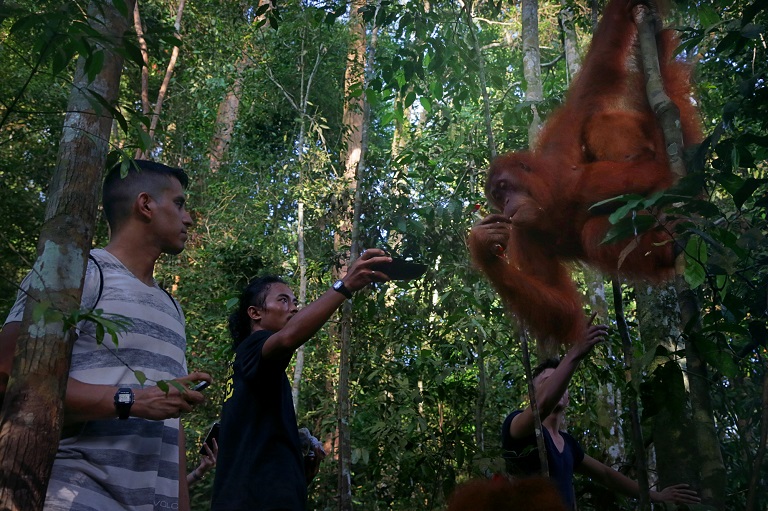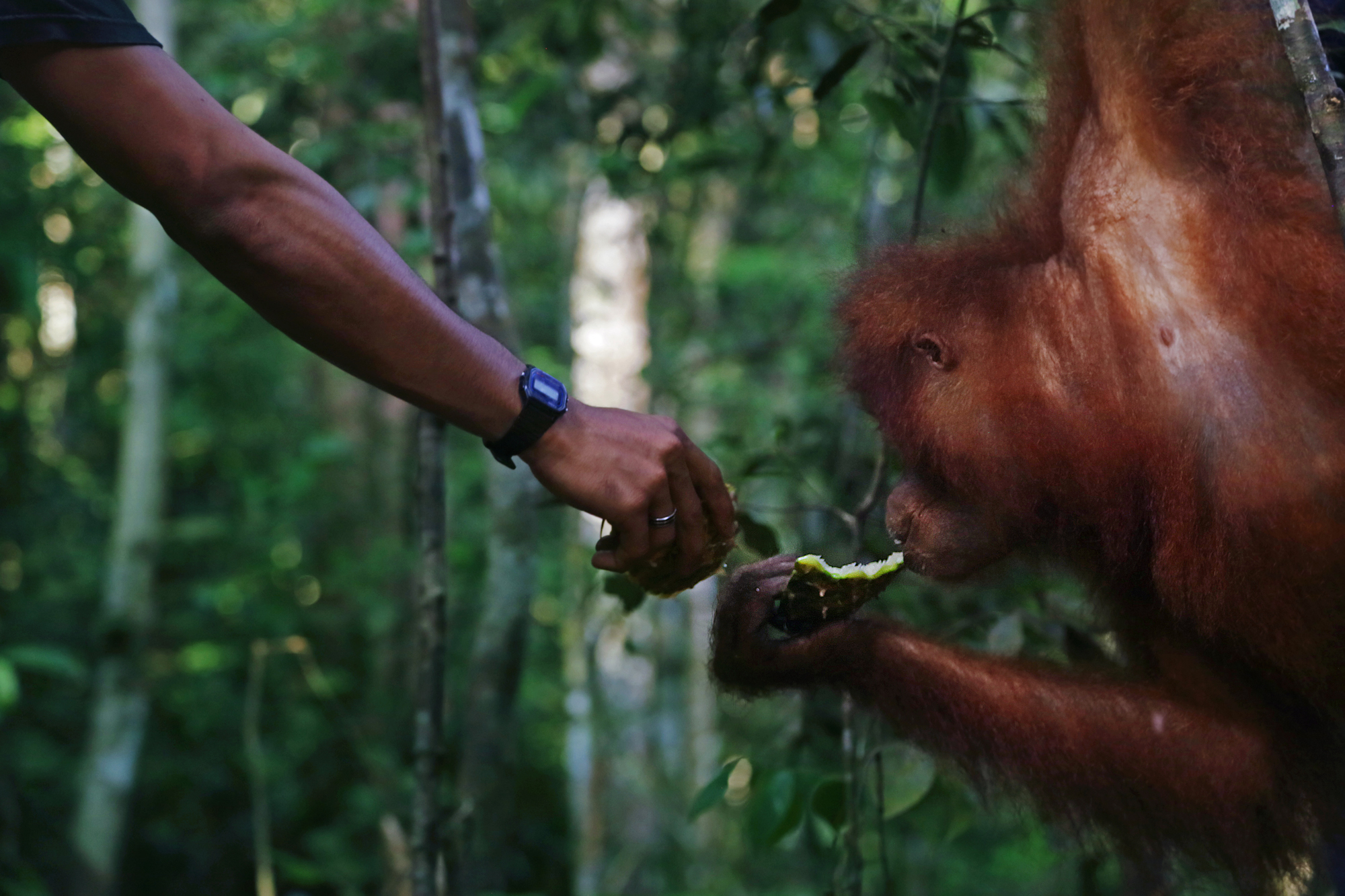By Aria Danaparamita
BUKIT LAWANG, Indonesia — About a dozen foreign tourists clamored around an orangutan and her young child.
“Can I take a photo with her?” a tanktop-clad backpacker asked. “Of course,” a local guide said.
In the orangutan’s hands was a plastic wrapper: snacks traded for the selfies.
I was on the second day of a three-day trek in Bukit Lawang, a village on the fringe of Mount Leuser National Park in Indonesia.
Sprawling some 2.6 million hectares across Aceh and North Sumatra provinces, the broader Leuser Ecosystem is home to the Sumatran rhinoceros (Dicerorhinus sumatrensis) and the Sumatran tiger (Panthera tigris sumatrae) as well as the Sumatran orangutan (Pongo abelii) — all critically endangered species.
Research published this year estimates there are around 14,600 of the orangutans left. Tourism sites like Rough Guides advertise Bukit Lawang as “some of the best opportunities to see wild orangutan in the world.”
Visitors are allowed to enter the national park with a guide. And a rise in tourism in recent decades has been a boon for Bukit Lawang villagers.
Most locals work as guides or in the hotels and restaurants lining the banks of the Bohorok River bordering the jungle. The village is the highest contributor to the district’s revenue, according to the local tourism association.
But trekking through the forest, it soon became clear that all that has come at a cost.

Bukit Lawang’s tourism history began with the Bohorok Orangutan Center. In 1973, two Swiss founded the rehabilitation facility for orangutans illegally kept as pets. It has since released over 200 orangutans into the wild.
Curious visitors followed, at first in limited numbers. Tourists came to watch the orangutans at feeding platforms where the number of people was officially restricted. Between 1989 and 1992, Bukit Lawang built 29 guesthouses — and mass tourism has only continued to rise.
Ian Singleton, director of the Sumatran Orangutan Conservation Program, described this 1990s tourist boom: “Extremely large numbers of local visitors regularly descended on the town every weekend and a steady stream of foreign tourists stayed for longer periods as they traveled through Southeast Asia on the backpacker trail.”
“Alcohol and drugs were abundant and even a ‘red light’ industry developed in what was locally known as Kampong Thailand,” he added.
The Bohorok center was deemed no longer fit to rehabilitate orangutans. In 1995, the forestry ministry released a directive prohibiting further releases there.
Without an alternative site, the center continued releasing orangutans until 2001, and the feeding platforms only closed earlier this year. Throughout, the tourists have kept coming.

I arrived in Bukit Lawang with a friend after a four-hour van ride from Medan, Sumatra’s biggest city.
We set out on our trek with Firman, a veteran guide, and his assistant. With 20 years experience plying through the jungle, Firman’s knowledge of the forest is unrivalled. And he is openly critical about the state of tourism in Bukit Lawang today.
As we entered the park, he pointed us to a large board which all hikers are urged to read. Do not feed the orangutans, it said.
That hasn’t stopped many from doing just that.
We had been watching a sleek, black siamang (Symphalangus syndactylus) swing high up in the trees when we heard the commotion.
Amid the crowd, guides were handing two orangutans fruits and packaged snacks. Our guide gave us a defeated look.
“It’s very bad but what can we do? Even if we don’t want to give them food, the other guides give them food. So now they are trained to expect it,” Firman said, adding that some orangutans have become hostile unless placated with something to eat.

Wildlife conservationists have raised alarm over the situation in Bukit Lawang.
Sumatran Orangutan Society director Helen Buckland lamented the feeding, close contact between humans and orangutans, and tourists disturbing wildlife. These “bad practices,” she said, “have led to situations that threaten the very wildlife that visitors travel so far to see in their natural habitat.”
Yet hundreds of tourists relish such interactions: Bukit Lawang consistently gets a 5-star rating on sites like TripAdvisor.
“The outing went far beyond our expectations,” one reviewer wrote on TripAdvisor. “Fabulous!”
Another reviewer wrote, “Orangutans are born comedians. You will see them mugging for handouts.”
The head of the local tour guides association, Bahagia Putra, admits that the blatant contact with orangutans is troubling, but says his organization can only do so much.
“There’s no specific regulation so we can’t say they violated the law, though we always remind them,” he said.

Meanwhile, Bahagia said the guides feel their hands are tied.
“Not all the tourists who come care about biology or the environment. Some of them only want to see orangutans — that’s it,” Bahagia said. “And it’s our job to deliver.”
But the problem isn’t just tourists.
Currently there are around 500 guides registered in Bukit Lawang, according to Bahagia. Only about 35 are properly certified, he said.
Our guide, Firman, was part of the older generation trained through a program under the government and the guides association. But for the hundreds of new guides, there’s no formal training or tests. You simply become a guide by “experience,” Bahagia explained.
He says this came out of necessity as the number of tourists kept increasing. “The older generation has less stamina now so we’re building the new generation,” he said.
Now, the forest is effectively left in the hands of those young men.

Orangutans continue to face the threat of extinction. At Bukit Lawang, experts emphasize that drastic changes need to take place to safeguard the fragile population.
“All orangutans that potentially have direct contact with wild orangutans should be completely, physically isolated from visitors to minimize the risks of disease transmission to the wild population,” the SOCP’s Singleton wrote.
“It is strongly recommended to begin concentrating tourism on Bukit Lawang’s other, non-orangutan assets, such as the forests themselves and other species, and begin to rely less on the ex-captive orangutans.”
The SOS’s Buckland added that, done properly, ecotourism has the potential to protect orangutans and their habitat.
“More training and awareness for guides and tourism professionals depending on biodiversity and nature, a better control of tourism practices and actors by relevant authorities, and a true and shared involvement of tourists and travel operators are still necessary,” she said.

After returning to the village at the end of our trek, Firman agreed that while tourism has helped the community, the forest and its orangutans have suffered.
“Bukit Lawang these days isn’t suitable for visiting anymore from a conservation perspective,” he said.
He wants to start a new ecotourism initiative away from orangutans, with treks focused on learning about the forest’s biodiversity. But as long as the orangutans keep bringing in cash, he’s not sure things will change.
“The local community worships money now, so whatever tourists want, they will do it,” Firman said. “Even if it violates conservation guidelines.”
This article originally published on environmental news site Mongabay.com. You can read the original article here.





[…] There are around 500 guides registered in Bukit Lawang, but only 35 are properly certified. It is illegal to trek without a guide, so you have to choose someone. Do your research online to find the guides who have a genuine care for the survival of the species, rather than those who encourage orangutan feeding. For more information, read this interesting article from Coconuts.co. […]